|
Our Favorite Images of Africa
During our month in southern Africa we took some
1,250 digital images. Of those, 501 are included in the pages of this journal.
We selected the images on this page as our favorite images of Africa.
 While in Knysna we visited an elephant sanctuary where we saw
this mother and two month old baby. We never knew that elephants cross their
hind legs, but we saw an older one do so. It doesn't get much cuter than this.
While in Knysna we visited an elephant sanctuary where we saw
this mother and two month old baby. We never knew that elephants cross their
hind legs, but we saw an older one do so. It doesn't get much cuter than this.
 We also visited Birds of Eden. I believe it is the largest aviary
in the world and you walk along raised walkways, sometimes within a few feet of
some spectacular birds. This one with the great eye makeup is a Knysna Lourie.
We also visited Birds of Eden. I believe it is the largest aviary
in the world and you walk along raised walkways, sometimes within a few feet of
some spectacular birds. This one with the great eye makeup is a Knysna Lourie.
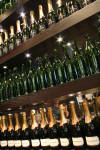 Our next stop was Franschhoek in the wine country northeast of
Cape Town. We took this shot at the Graham Beck winery. It is very modern and
makes some wonderful wines.
Our next stop was Franschhoek in the wine country northeast of
Cape Town. We took this shot at the Graham Beck winery. It is very modern and
makes some wonderful wines.
 From Franschhoek it was back to Cape Town and a visit to the
penguin beach to the south. These two had just come out of the water and the guy
on the left looks like a real happy camper.
From Franschhoek it was back to Cape Town and a visit to the
penguin beach to the south. These two had just come out of the water and the guy
on the left looks like a real happy camper.
 We flew from Cape Town to Johannesburg and drove to Zulu Nyala -
a safari camp in KwaZulu-Natal. There we saw these two giraffes 'necking' or
something.
We flew from Cape Town to Johannesburg and drove to Zulu Nyala -
a safari camp in KwaZulu-Natal. There we saw these two giraffes 'necking' or
something.
 This adult male impala is one of the most beautiful animals we
saw. The locals refer to them as McDonalds because there is one around every
corner and they have markings on their rumps that look like the letter M.
This adult male impala is one of the most beautiful animals we
saw. The locals refer to them as McDonalds because there is one around every
corner and they have markings on their rumps that look like the letter M.
 We went out on game drives in open Land Rovers and saw a lot of
animals, including this mother zebra and nursing foal. We learned that even if
you could tame a zebra it would be useless because its back is too weak to be
ridden or used as a pack animal. Still, they are striking animals.
We went out on game drives in open Land Rovers and saw a lot of
animals, including this mother zebra and nursing foal. We learned that even if
you could tame a zebra it would be useless because its back is too weak to be
ridden or used as a pack animal. Still, they are striking animals.
 On one evening stop for sundowners (drinks and snacks out of the
vehicle) we captured this image of a snag at dusk. The sundown that followed was
spectacular.
On one evening stop for sundowners (drinks and snacks out of the
vehicle) we captured this image of a snag at dusk. The sundown that followed was
spectacular.
 We went back to Johannesburg and visited Soweto - an abbreviation
for South Western Township. Soweto was the site of uprisings (over the
requirement to have school taught in Afrikaans) that eventually led to the end
of apartheid. The muffler man caught our eyes.
We went back to Johannesburg and visited Soweto - an abbreviation
for South Western Township. Soweto was the site of uprisings (over the
requirement to have school taught in Afrikaans) that eventually led to the end
of apartheid. The muffler man caught our eyes.
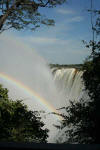 From Johannesburg we flew to Livingstone, Zambia and were
transported to the Royal Livingstone Hotel on the banks of the Zambezi river and
just up from Victoria Falls. We were treated to a number of rainbows on a
morning walk to see the falls. We also got soaked and fried one our lenses.
From Johannesburg we flew to Livingstone, Zambia and were
transported to the Royal Livingstone Hotel on the banks of the Zambezi river and
just up from Victoria Falls. We were treated to a number of rainbows on a
morning walk to see the falls. We also got soaked and fried one our lenses.
 This, believe it or not, is the site of the border crossing from
Zambia to Botswana. It looks like a cross between an uneven dirt parking lot, a
wrecking yard, and a flea market. We were driven here from the hotel, handed
over to a fellow in a 16' aluminum outboard motor boat that was beached at the
left of this shot, taken across the river and beached on the Botswana side, and
handed over to another driver. It was a hoot!
This, believe it or not, is the site of the border crossing from
Zambia to Botswana. It looks like a cross between an uneven dirt parking lot, a
wrecking yard, and a flea market. We were driven here from the hotel, handed
over to a fellow in a 16' aluminum outboard motor boat that was beached at the
left of this shot, taken across the river and beached on the Botswana side, and
handed over to another driver. It was a hoot!
 We were flown to Chitabe Trails in a six-seater Cessna. On one of
our game drives we came nose to trunk with this elephant. It is rather unnerving
being that close to something that large.
We were flown to Chitabe Trails in a six-seater Cessna. On one of
our game drives we came nose to trunk with this elephant. It is rather unnerving
being that close to something that large.
 We had hoped to see a leopard and our guide finally found this
female. She had caught a Ververt monkey the night before and was snoozing near
the remains, oblivious to everything except the insects buzzing around her head.
We had hoped to see a leopard and our guide finally found this
female. She had caught a Ververt monkey the night before and was snoozing near
the remains, oblivious to everything except the insects buzzing around her head.
 Later we saw this male that was on a mission and strolled right
past our vehicles. He was much larger and darker than the female we had seen
earlier. He never even looked our way.
Later we saw this male that was on a mission and strolled right
past our vehicles. He was much larger and darker than the female we had seen
earlier. He never even looked our way.
 Next up was a pair of male lions we found sleeping along one of
the roads. They finally roused themselves and treated us to some very impressive
yawns. Then they started a roaring contest and we were stunned by the volume
these guys produced.
Next up was a pair of male lions we found sleeping along one of
the roads. They finally roused themselves and treated us to some very impressive
yawns. Then they started a roaring contest and we were stunned by the volume
these guys produced.
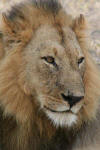 We saw the same two lions the next morning at a different
location. They were ignoring a nearby giraffe that was not ignoring them, so we
assumed they had dined recently. Is that the king, or what?
We saw the same two lions the next morning at a different
location. They were ignoring a nearby giraffe that was not ignoring them, so we
assumed they had dined recently. Is that the king, or what?
 Our next stop was Vumbura Plains, also in Botswana. Just across
the pond from the camp we found a pride of lions. We had been told that animals
see our Land Rover as one large object and don't distinguish individual people
inside. B...s...! Sure looks like this guy is making eye contact with me!
Our next stop was Vumbura Plains, also in Botswana. Just across
the pond from the camp we found a pride of lions. We had been told that animals
see our Land Rover as one large object and don't distinguish individual people
inside. B...s...! Sure looks like this guy is making eye contact with me!
 The birds in Africa are incredible. This is a Lilac-Breasted
Roller. I would never have thought to put together such a color scheme, but then
I'm a fairly conservative dresser.
The birds in Africa are incredible. This is a Lilac-Breasted
Roller. I would never have thought to put together such a color scheme, but then
I'm a fairly conservative dresser.
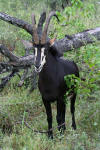 We had not previously seen Sable antelopes and found that the
younger ones are much lighter in color. This fellow looks like a reasonably
young mature adult male, but he also looks like he is smiling for the camera.
We had not previously seen Sable antelopes and found that the
younger ones are much lighter in color. This fellow looks like a reasonably
young mature adult male, but he also looks like he is smiling for the camera.
 We don't recall the name of this stork-like bird, but he is very
impressive. His long beak is brightly colored and his wings, when open like
this, are gorgeous.
We don't recall the name of this stork-like bird, but he is very
impressive. His long beak is brightly colored and his wings, when open like
this, are gorgeous.
 This male kudu is an adult, but not that old. His horns will
eventually make three complete twists. If he doesn't survive, one of them may
end up in a safari camp and be used to wake up the guests at 5:50 AM. Kudu horns
are REALLY loud!
This male kudu is an adult, but not that old. His horns will
eventually make three complete twists. If he doesn't survive, one of them may
end up in a safari camp and be used to wake up the guests at 5:50 AM. Kudu horns
are REALLY loud!
 The sunsets were spectacular. We often got to see them while
sipping sundowner drinks out of the vehicle. This one was in Botswana and was a
real treat.
The sunsets were spectacular. We often got to see them while
sipping sundowner drinks out of the vehicle. This one was in Botswana and was a
real treat.
 This sunset was in Namibia. We had traveled by charter and
commercial flight to Windhoek, and then by another charter to a desert camp at
Sossusvlei. It was very stark, but the sunsets were still great.
This sunset was in Namibia. We had traveled by charter and
commercial flight to Windhoek, and then by another charter to a desert camp at
Sossusvlei. It was very stark, but the sunsets were still great.
 The highlight of this area is the sand dunes that are hundreds of
feet tall. In the early morning they are lit on one side and in shadow on the
other. The contrast is quite spectacular.
The highlight of this area is the sand dunes that are hundreds of
feet tall. In the early morning they are lit on one side and in shadow on the
other. The contrast is quite spectacular.
 It's a long drive to get to the dunes and a long walk to climb
the peak line. The sand is very soft and climbing is hard work, even if you get
started before it gets too hot.
It's a long drive to get to the dunes and a long walk to climb
the peak line. The sand is very soft and climbing is hard work, even if you get
started before it gets too hot.
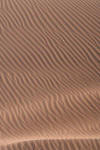 The wind and animal tracks make some very interesting patterns in
the soft sand of the dunes. Even little beetles and geckos can make some
distinct patterns.
The wind and animal tracks make some very interesting patterns in
the soft sand of the dunes. Even little beetles and geckos can make some
distinct patterns.
 We went down the shadow side of the dune into Dead Vlei. By the
time we reached the vlei we had a cup of sand in each shoe. The dead trees in
the vlei and the very light color of the floor provide a stark contrast with the
red sand of the dunes.
We went down the shadow side of the dune into Dead Vlei. By the
time we reached the vlei we had a cup of sand in each shoe. The dead trees in
the vlei and the very light color of the floor provide a stark contrast with the
red sand of the dunes.
 We had seen weaver bird nests in other areas, but they were
individual nests hanging from tree branches. In the Namibian desert there are
communal weavers that build these huge structures in trees. They may be half the
size of a VW beetle. Each nesting pair has their own entrance to their area of
the nest.
We had seen weaver bird nests in other areas, but they were
individual nests hanging from tree branches. In the Namibian desert there are
communal weavers that build these huge structures in trees. They may be half the
size of a VW beetle. Each nesting pair has their own entrance to their area of
the nest.
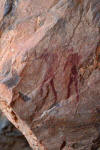 On our last morning at Sossusvlei we were taken to see cave
paintings left by San people over 20,000 years ago. The two figures were perhaps
9" tall and were still quite distinct.
On our last morning at Sossusvlei we were taken to see cave
paintings left by San people over 20,000 years ago. The two figures were perhaps
9" tall and were still quite distinct.
 Some of the more interesting creatures were the smaller ones,
although this spider is large for his type of critter. He spins this very
unusual zigzag pattern in his web. We've no idea what the purpose might be.
Some of the more interesting creatures were the smaller ones,
although this spider is large for his type of critter. He spins this very
unusual zigzag pattern in his web. We've no idea what the purpose might be.
We hope you have enjoyed these photographic
highlights of our journey. The entire trip is described in much more detail with
many more photos and is accessible via the menu at the top of the page.
|